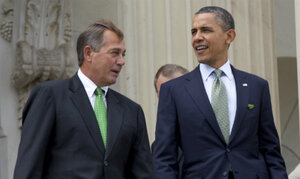To avoid 'fiscal cliff,' try mediation
The 'fiscal cliff' needs urgent attention, but the election returned the same House/Senate/White House configuration that failed to agree on the budget ceiling in 2011. More active participation by President Obama combined with mediation could help bridge the congressional divide.

House Speaker John Boehner of Ohio and President Obama walk down the steps of the Capitol on March 20. Op-ed contributor L. Michael Hager writes: 'Two experienced mediators, one from each party and both acceptable to Democrat and Republican negotiators, could be appointed as co-mediators.'
Carolyn Kaster/AP/file
Washington
The looming “fiscal cliff” is rattling the financial markets, attracting rating agency scrutiny, and fueling public anxiety. Its automatic spending cuts and tax increases would hurt everyone. It would leave the military reeling. Leading economists predict a severe recession if the cliff issues are not resolved by Jan. 1, when they are set to go into effect.
Nor is postponement of compromise – as House Speaker John Boehner proposes – the right answer. Legislation that simply “kicks the can down the road” would leave in place an uncertainty that would invite credit downgrades and further stock-market decline.
The cliff needs urgent attention, but the election returned the same House/Senate/White House configuration that failed to agree on the budget ceiling in 2011. So what’s different this time?
For one thing, President Obama does not face reelection, so that might give him more latitude for compromise. And it’s encouraging that he and congressional leaders of both parties have pledged to reach across the aisle, and will meet in Washington later this week.
Yet the reach may fall short of a handshake. House Speaker Boehner’s post-election day remarks to the press sounded conciliatory. “Mr. President, the Republican majority in the House of Representatives stands ready to work with you to do what’s best for our country.”
He expressed a willingness to accept revenue increases along with spending cuts. However, the speaker made clear that the revenue increases he has in mind are those that would result from the elimination of undefined tax breaks, not on tax increases on the wealthy, as Mr. Obama wants. Sounds like the same uncompromising rhetoric we heard before the election.
The Jan. 1 deadline presents the lame duck Congress with a golden opportunity to reach at least the framework of a historic agreement, one that would address spending cuts, entitlement restructuring, tax reform, the Bush tax cuts, and the debt ceiling.
More active intervention by the president is a logical and necessary first step to agree on the outlines of a deal. Woodrow Wilson used the joint session of Congress repeatedly to advance his positions. FDR, Lyndon Johnson, and Ronald Reagan brought to bear the power of the presidency in more intimate gatherings. Bill Clinton mobilized public pressure through the bully pulpit. Obama might use any or all of these tools, largely neglected in his first term, to push forward an agreement.
Mediation is another tool that could facilitate agreement. Two experienced mediators, one from each party and both acceptable to Democrat and Republican negotiators, could be appointed as co-mediators. While legislative mediation has not been tried in Congress, it was used successfully in 2001 by the Illinois General Assembly to craft a telecommunications act that was set to expire when the state regulator and local carriers affected by the law were unable to compromise.
The mediators would first establish to the satisfaction of both sides an efficient procedure for one-party caucuses and sessions where all players meet together. They would secure an understanding of confidentiality during the negotiation process, lessening the pressure of outside interest groups during the delicate dealmaking.
Finally, the co-mediators would stimulate creative thinking by asking the negotiators “what if...?” questions that would test the interests of each side and help move the parties toward agreement.
The late Prof. Roger Fisher, co-author of the perennial bestseller “Getting to Yes,” showed how negotiators often fail to agree because they lack a process for exploring and meeting the essential interests of both parties. He called the process a “win-win.”
The multiplicity of issues in play (spending cuts, entitlements, tax reform, and tax cuts) as well as the multiple possibilities for staging tax cuts over time are the raw materials for a win-win solution. A co-mediator team could help the parties understand their respective interests and prompt them to devise trade-offs that satisfy the interests of both parties. However, the two parties themselves, not the mediators, would decide the ultimate outcome.
More active participation by President Obama combined with co-mediation could help bridge the congressional divide and provide a useful precedent for bipartisan dealmaking over the next four years.
L. Michael Hager is the former executive director of the Conflict Management Group and the co-founder and former director general of the International Development Law Organization.

